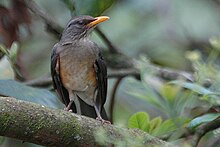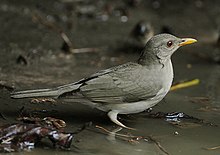African thrush
| African thrush | |
|---|---|

| |
| Scientific classification | |
| Domain: | Eukaryota |
| Kingdom: | Animalia |
| Phylum: | Chordata |
| Class: | Aves |
| Order: | Passeriformes |
| Family: | Turdidae |
| Genus: | Turdus |
| Species: | T. pelios
|
| Binomial name | |
| Turdus pelios | |
TheAfrican thrushorWest African thrush(Turdus pelios) is apasserinebirdin thethrushfamily Turdidae. It is common in well-wooded areas over much of the western part of sub-SaharanAfrica,it was once considered to be conspecific with theolive thrushbut that species has now been split further. Populations are resident (non-migratory).
Description
[edit]The African Thrush has dark olive-grey upperparts. The underparts show a whitish evenly brown- streaked side throat, the breast is greyish brown and the flanks are pale buff-orange with this colour not extending on to the lower breast, the belly and vent are white. It has a yellow-orange bill.[3]It weighs 46–78 g (1.6–2.8 oz) and measures 21–23 cm (8.3–9.1 in) in length.[4]
Voice
[edit]The song of the African thrush is a sustained, clear warbling made up of different phrases repeated rather randomly in a sequence. Also a high-pitched squealing flight call.[5]
Distribution
[edit]The African thrush is distributed fromSenegalandGambiain the west toSouth Sudan,EthiopiaandEritreasouth to northwesternZambiaand westernAngola.[6]
Habitat
[edit]The African thrush can be found in all sorts of wooded habitats including forest edge, riparian woodland, scrub cultivation, parks and gardens.[4]
Habits
[edit]The African thrush is normally encountered either singly or in pairs and is shy and retiring, preferring to remain in cover, but will come out and gather at fruiting trees. Usually forages in the ground, flickingleaf litterand searching through vegetation. Where undisturbed or habituated to people will feed out in the open in a similar fashion to thesong thrushin Europe, and it is also reported to crack open snails on an anvil stone like a song thrush. Foraging is crepuscular and fruit, especially that of the nimAzadarichta indica,as well asfigs,papaya,berriesand seeds, makes up most of the diet supplemented with invertebrates and the occasional small fish.[7]

Breeding is recorded in all months, but breeding activity peaks in the wet season, which is March to September or October in West Africa, April–July in Ethiopia and November to March in the rest of its range. The nest is cup shaped and bulky and is constructed using plant fibres and mud lined with fine grasses, leaves and roots. This nest is placed on a horizontal branch, in a tree fork or among vines, usually at a height lower than 10 m from the ground. It may re-use the abandoned nest of another species. The female is responsible for incubating the normal clutch of 2–3 eggs; both sexes feed the young. It is double brooded.[7]
Taxonomy
[edit]The African thrush may be part of asuperspecieswith theKurrichane thrushand thebare-eyed thrush,[4]and somesubspeciesof African thrush (T.p. poensis,T.p.nigrilorum,T.p. centralisandT.p. chinguanicoides) have been considered subspecies ofolive thrush.[7]
The currently recognised subspecies and their distributions are:[2][4]
- Turdus pelios chiguancoidesSeebohm, 1881:Senegal east to northernGhana.
- Turdus pelios saturatus(Cabanis, 1882):west Ghana east to centralCameroon,westernCongoandGabon.
- Turdus pelios nigrilorumReichenow, 1892:Mount Cameroon.
- Turdus pelios poensisAlexander, 1903:Bioko(formerly Fernando Póo).
- Turdus pelios peliosBonaparte, 1850:eastern Cameroon east to South Sudan, western Eritrea and western, central and eastern Ethiopia.
- Turdus pelios centralisReichenow, 1905:eastern Congo and southernCentral African Republiceast to southern Ethiopia, westernKenyaand north-westernTanzania.
- Turdus pelios bocagei(Cabanis, 1882):westernDemocratic Republic of Congoand north-western and western Angola.
- Turdus pelios graueriNeumann, 1908:eastern Democratic Republic of Congo,Burundi,Rwandaand western Tanzania.
- Turdus pelios stormsiHartlaub, 1886:south-eastern Democratic Republic of Congo, eastern Angola and northern Zambia.
References
[edit]- ^BirdLife International (2016)."Turdus pelios".IUCN Red List of Threatened Species.2016:e.T22708702A94172703.doi:10.2305/IUCN.UK.2016-3.RLTS.T22708702A94172703.en.Retrieved12 November2021.
- ^ab"Turdus peliosBonaparte 1850 ".Integrated Taxonomic Information System (ITIS) (https:// itis.gov).Retrieved2016-11-08.
- ^"The African Thrush".Uganda Birding Safari Guide.Africa-Uganda-Business-Travel-Guide.Retrieved2016-11-08.
- ^abcd"African Thrush (Turdus pelios) ".Handbook of the Birds of the World Alive.Lynx Edicions.Retrieved2016-11-08.
- ^Barlow, Clive; Wacher, Tim; Disley, Tony (1997).A Field Guide to the Birds of The Gambia and Senegal.Pica Press. p. 297.ISBN1-873403-32-1.
- ^"African ThrushTurdus peliosBonaparte, 1850 ".Avibase.Denis Lepage.Retrieved2016-11-08.
- ^abcClement, Peter; Hathway, Ren; Byers, Clive; Wiczur, Jan (2000).Thrushes.Christopher Helm. pp. 326–329.ISBN0713639407.

